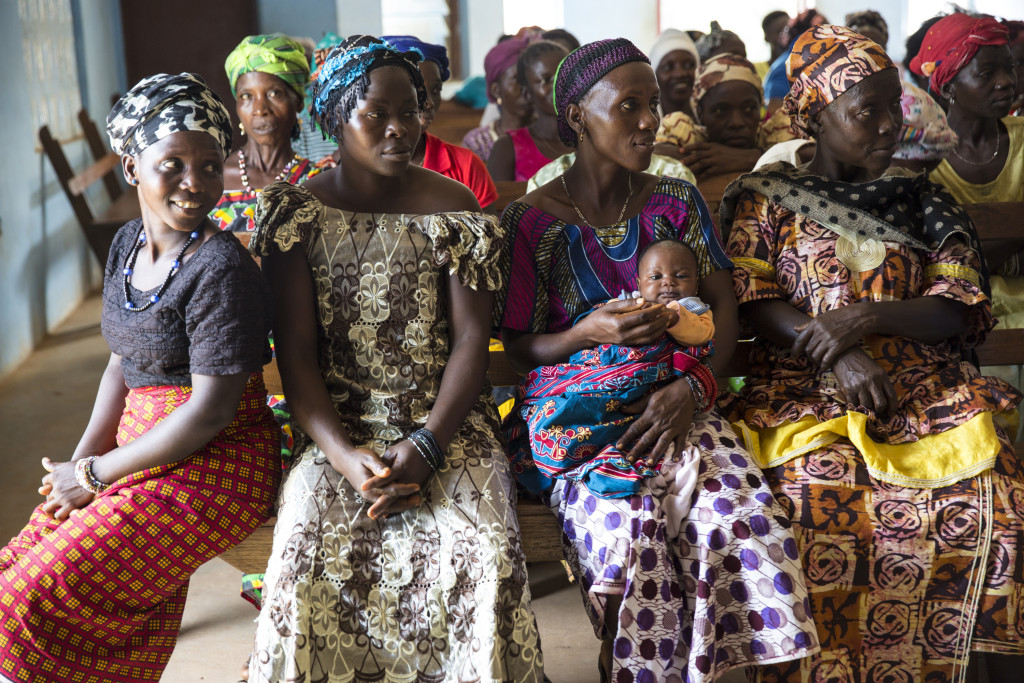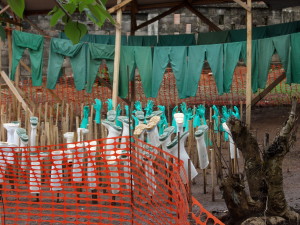
Community members attend a briefing by a social mobilization team in Lester Road, Freetown UN Photo/Martine Perret
At the time of the 2014-15 West Africa outbreak, the aim of SBCC was to engage communities with information and a responsive environment so that they could understand what was going on, take ownership of their situation and perform the necessary actions to prevent Ebola.
It was critical to create a feedback loop between communities and health service providers to ensure effective and coordinated community engagement. This would ensure that treatment, surveillance, quarantine and burial services were understood and met the needs of communities.
Coordination Mechanism Functions
An Ebola communication coordination mechanism at the national and local levels can provide the following functions:
Coordinate initiatives at all levels
Develop harmonized and coordinated messages and materials to promote appropriate behaviors
Promote messages through mass media and trusted spokespersons
Coordinate SM within the broader Ebola response at all levels
Support structures at all levels that can quickly train mobilizers on interpersonal communication interventions
Ensure that all mobilizers have sufficient support to safely conduct activities in their local contexts and have mechanisms to report feedback
Monitor SM and communication activities and develop a mechanism to quickly analyze and inform responses and programs
While all countries affected in this outbreak created coordination mechanisms, each varied in structure. International communication experts on the ground identified the following as critical core functions of any coordination mechanism:
Leadership: ensuring representation among responding agencies, harmonization of efforts, consistency of practice and awareness of activities
Strategizing: creating/sustaining partnerships, developing and implementing response game plan and vision, and authorizing materials/activities/funding
Planning: setting goals, supporting human capacity, leveraging resources, advocating for the role of communication/community engagement, providing technical assistance, organizing/inventory of resources, housing information management systems and capacity building
Ebola Communication Coordination Team
A central Ebola communication coordinating mechanism includes all the key players from the MOH; communication or information ministries; medical and nursing associations; international health and development organizations such as WHO, UNMEER, UNICEF, and the International Federation of the Red Cross, as well as all key international agencies working in the field of health and health communication. This coordination team needs to be able to mobilize immediately once the outbreak begins and meet on a regular basis to respond to ongoing developments.
Ebola Communication Subcommittees
The development of Ebola communication team subcommittees ensures that smaller groups focus on each aspect of the effort, while at the same time ensuring coordination, message consistency and information sharing. This is critical to help avoid confusion that can undermine public trust, raise levels of fear and anxiety, and hinder response measures.
For example, a media subcommittee might identify point person(s) for press conferences and message dissemination for the group as a whole, as well as a point person for any communication from each individual agency. The press and media personnel need to be partners in the process from the beginning so that news stories that are not controlled by the MOH are accurate, consistent with messages and policies, and do not create undue panic or perpetuate rumors.
A community action subcommittee could begin by creating a list of all national and local organizations including religious, sports and youth groups. This subcommittee can also develop a directory of mayors or other local elected leaders, religious leaders, traditional leaders and leaders of sectors such as education, agriculture, fisheries, water, etc., to act as additional channels for message dissemination and SM efforts at the local level.
A social science research subcommittee could coordinate all the social science research and the monitoring and evaluation (M&E) activities related to the communication response. This committee can monitor social science research to ensure that all findings are shared and that any identified gaps are addressed. Similarly, this group can be responsible for developing the M&E framework and for ensuring that the dashboard containing this critical information is updated regularly. Coordination units at the district level should be established or, if present, strengthened in areas of active Ebola transmission. Highest priority should go to areas of intense transmission, capital cities and major hubs in other transmission zones.
Such units should be hosted by the relevant district health authority, representatives of other government authorities, WHO, UNICEF, key NGOs and technical agencies and other major implementing partners. This group can facilitate the implementation and monitoring of the full Ebola package—or complementary approaches, if necessary—in all affected localities.
Finally, roles and assignments will shift as the outbreak evolves. The team needs to remain flexible in light of the changing circumstances, taking on more responsibilities as needed. It should be clear to the team from the outset that their flexibility is critical to the control of the Ebola outbreak.
Integrating Ebola Communication into the Emergency Response
In order to facilitate greater efficiency in case management, contact tracing, quarantine, and safe burial teams, SM should be integrated and coordinated with the emergency response. Social mobilizers can explain to households what to expect from these emergency responders and what to do while they wait for them. Communities will then be better prepared and more willing to allow emergency responders—many of whom will be covered head-to-toe in personal protection equipment (PPE)—to enter households.
To integrate the teams, the central Ebola coordinating mechanism should include social mobilizers within trigger mechanisms for alerts that countries can develop (e.g., when there is a death or suspected Ebola case in a community). When there is an alert, mobilizers assigned to a particular area can join the response teams. They may arrive before the other teams to facilitate smooth entry into communities and family homes, and may stay after other teams leave, in order to answer any additional questions community members may have. For more information about integrating social mobilizers into the emergency response, see Chapter 5. Community Engagement in the Ebola Response.

